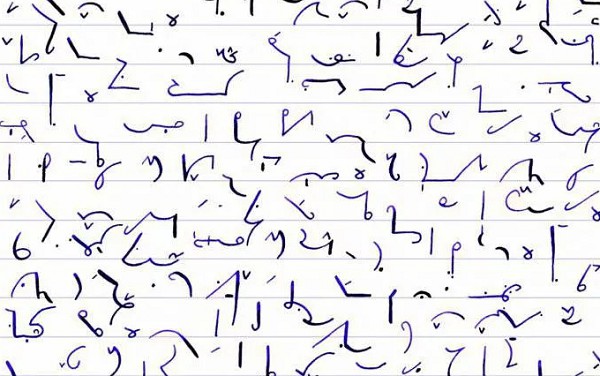Another type of writing that JIT.Academy did not have time to tell you about is shorthand or stenography. More precisely, it is fast writing.
Stenography (sometimes called “cursive writing”) comes from the Greek words: στενός – narrow or cramped and γράφειν – to write. It was invented to quickly and synchronously transfer spoken language into writing through short signs, letters, abbreviations, or geometric elements (point, straight line, circle). A particular sign can replace a whole word, a separate syllable, or even a sound.
Who needs shorthand? Politicians, journalists, translators, scientists, writers, lawyers, and representatives of many other professions. It is used, for example, during the work of the parliament, court hearings, and for recording information at press conferences.
Amazing that shorthand is related to cryptography in its own way because everyone can invent their own system of cursive writing, which is challenging for outsiders to understand.
According to several sources, shorthand was used by the ancient Egyptians, who recorded the speeches of the pharaohs using conventional signs. Later, this art was passed to the Greeks and Romans.
Tironian notes or the oldest system of shorthand in the world
In the first century BC, Tiro, a former slave of Marcus Tullius Cicero, invented a unique shorthand method. It was called “Tironian notes” – notae Tironianae. Interestingly, they were first mentioned in 1550 by the French lawyer Jacques Goury, and until then, they were called “notes” of Cicero or Seneca.
By shortening, merging, and simplifying Roman capital letters, Roman scribes (notarii) recorded public speeches and minutes of meetings. Symbolic designations were used for some vowel sounds. The first stenographic record with such signs was made on December 5, 63 BC, during a meeting of the Senate.
During the times of the Roman Empire, this cursive writing system was studied in schools; it was often used by writers and later by the Christian church.
The Tironian system of synchronous recording consisted of 5,000 elements; it became the basis of modern shorthand systems. In general, Roman tachygraphy (shorthand in antiquity and the Middle Ages) is considered the oldest known system of cursive writing. Manuscripts written in Tironian notes have survived to this day.
From the Middle Ages to the New Age
Tironian notes practically ceased to be used in the 11th century. It is known that in 1174 the English monk John of Tilbury tried to create a new system of shorthand based on Latin. In the Middle Ages and at the beginning of modern times, speeches were recorded in the usual alphabet but with contractions that were then added.
The first stenographic society was founded in 1726 in London.
Several stenographic institutes were established to promote the development of the theory, practice, and literature of stenography. In 1839, the “Königliches Stenographisches Institut” was founded in Dresden. In 1872, the Frenchman Emile Duploye founded the “Institut sténographique des Deux-Mondes” in Paris.
In 1851, the British stenographer Isaac Pitman opened the Phonetic Institute in Bath (Great Britain), with branches in London and New York. By the way, Pitman’s shorthand textbook “Phonohgraphic teacher” survived more than 100 editions. Pitman’s system was adopted not only in England but to a large extent in North America, Australia, and other countries.
The first magazine devoted to shorthand was published in England in 1842. The first international stenographic congress was held in 1887.
In Imperial China, clerks used a cursive form of Chinese characters to record court hearings and criminal confessions. The general term for Chinese shorthand styles is caoshu. “Shu” in this case means “writing, handwriting,” and “cao” is translated as “quick, sloppy, careless.” However, the character “cao” has another meaning – “grass,” so Chinese cursive is also called “grass script.”
All varieties of Chinese cursive are characterized by fluidity, continuity, and speed; therefore, the writing often looks illegible.
In Poland, the founder of shorthand was the writer and journalist Jan Nepomucen Kazimierz Krupski. In 1828, he wrote the first Polish textbook of geometric cursive writing. His work was based, in particular, on studies of the experience of French and English stenographers. This system was eventually applied to the Ukrainian language.

 Українська
Українська Русский
Русский




















 Анна викладає англійську вже три роки, працюючи з учнями різних вікових категорій на індивідуальних та групових заняттях. Здобувши ступінь бакалавра з психології у Львівському національному університеті, Анна завжди прагне знайти індивідуальний підхід до кожного студента, мотивуючи і допомагаючи їм справлятися з труднощами. Вдосконаливши своє знання англійської мови в Великобританії, важливим аспектом в своїй роботі вважає обмін викладацьким досвідом з носіями мови.
Анна викладає англійську вже три роки, працюючи з учнями різних вікових категорій на індивідуальних та групових заняттях. Здобувши ступінь бакалавра з психології у Львівському національному університеті, Анна завжди прагне знайти індивідуальний підхід до кожного студента, мотивуючи і допомагаючи їм справлятися з труднощами. Вдосконаливши своє знання англійської мови в Великобританії, важливим аспектом в своїй роботі вважає обмін викладацьким досвідом з носіями мови.